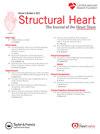Change in Dicrotic Notch Index Predicts Outcomes in Patients Undergoing Transcatheter Edge-to-Edge Repair for Mitral Regurgitation
IF 1.4
Q3 CARDIAC & CARDIOVASCULAR SYSTEMS
引用次数: 0
Abstract
Background
Changes in the dicrotic notch characteristics in the aortic pressure waveform have not been adequately studied with mitral transcatheter edge-to-edge repair (M-TEER). In this study, we sought to determine the changes in the dicrotic notch index (DNI) with M-TEER and identify their significance in determining procedural success.
Methods
We retrospectively analyzed patients undergoing M-TEER between 2019 and 2022 at our institution. DNI ([systolic-dicrotic pressure]/[systolic-diastolic pressure]) was calculated from invasive ascending aortic pressure waveforms. The cut point for change in DNI was determined and used to compare differences in composite clinical outcomes of mortality and heart failure hospitalization. To identify the determinants of change in DNI, variables including post-M-TEER MR and change in forward stroke volume (FSV) were measured.
Results
Of the 145 patients included in the study cohort, DNI significantly increased after M-TEER (0.49 ± 0.11 to 0.52 ± 0.11, p < 0.001). A cut point of 2.71% change in DNI identified higher probability of event-free survival at 1 year. Using this cut point, change in DNI was an independent predictor of event-free survival (hazard ratio: 0.45 [95% CI: 0.21-0.99], p = 0.01). Of the studied variables, change in FSV was the only predictor of change in DNI (hazard ratio: 0.187 [95% CI: 0.072-0.302], p = 0.002) with significant correlation (r = 0.30, p < 0.001).
Conclusions
DNI increases after M-TEER, and the magnitude of increase in DNI is associated with better clinical outcomes. Further, increase in FSV correlates with increase in DNI. DNI measured during M-TEER procedure provides an additional simple measure of procedural success.
Dicrotic Notch指数的变化预测二尖瓣返流患者行经导管边缘对边缘修复的预后
背景:二尖瓣经导管边缘到边缘修复术(M-TEER)对主动脉压力波形中二变切迹特征的改变尚未得到充分的研究。在这项研究中,我们试图用M-TEER来确定dicrotic缺口指数(DNI)的变化,并确定它们在决定手术成功中的意义。方法回顾性分析2019年至2022年在我院接受M-TEER治疗的患者。DNI([收缩压-二向压]/[收缩压-舒张压])由有创升主动脉压波形计算。确定了DNI变化的切点,并用于比较死亡率和心力衰竭住院治疗的综合临床结果的差异。为了确定DNI变化的决定因素,测量了m - teer后MR和前冲程体积(FSV)变化等变量。结果纳入研究队列的145例患者中,M-TEER后DNI显著升高(0.49±0.11 ~ 0.52±0.11,p <;0.001)。DNI变化的切点为2.71%,表明1年无事件生存的可能性更高。使用这个切点,DNI的变化是无事件生存的独立预测因子(风险比:0.45 [95% CI: 0.21-0.99], p = 0.01)。在研究的变量中,FSV的变化是DNI变化的唯一预测因子(风险比:0.187 [95% CI: 0.072-0.302], p = 0.002),相关性显著(r = 0.30, p <;0.001)。结论M-TEER后DNI升高,DNI升高的幅度与较好的临床效果相关。此外,FSV的增加与DNI的增加相关。在M-TEER过程中测量的DNI提供了手术成功的额外简单衡量标准。
本文章由计算机程序翻译,如有差异,请以英文原文为准。
求助全文
约1分钟内获得全文
求助全文
来源期刊

Structural Heart
Medicine-Cardiology and Cardiovascular Medicine
CiteScore
1.60
自引率
0.00%
发文量
81
 求助内容:
求助内容: 应助结果提醒方式:
应助结果提醒方式:


